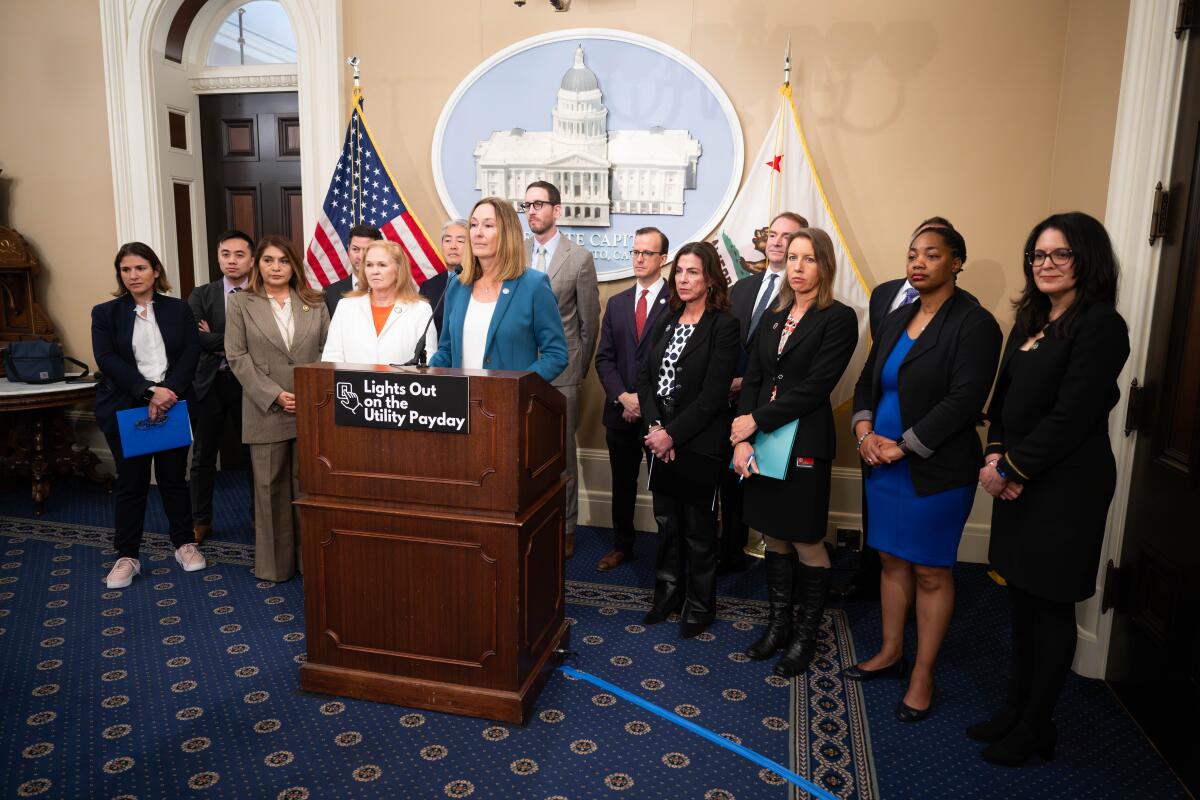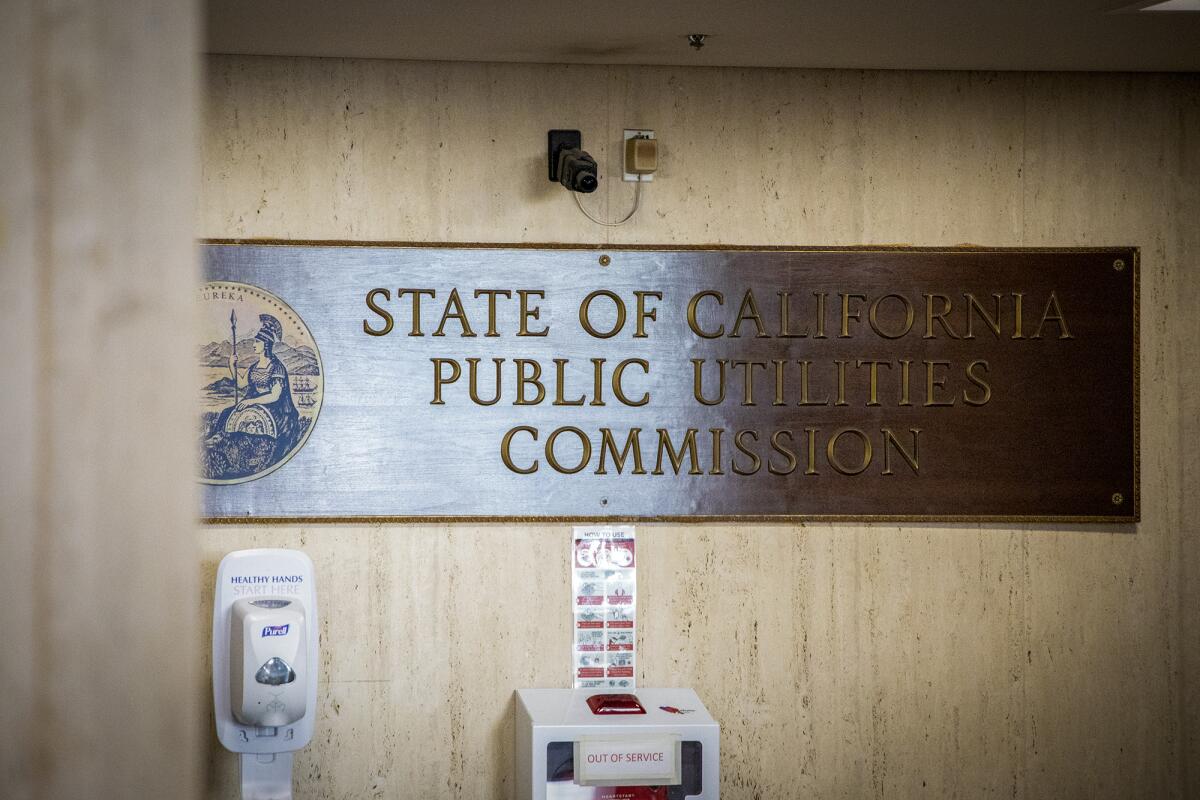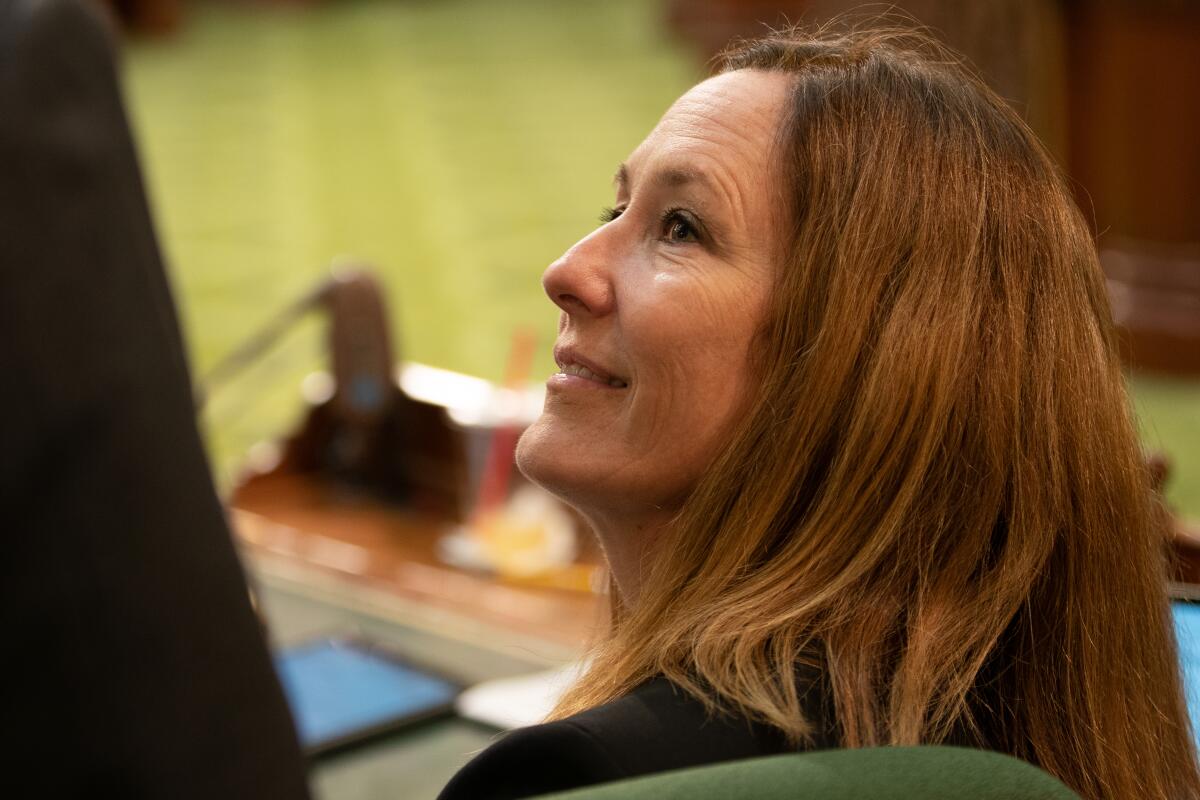Column: Who should pay for climate solutions? The debate is heating up

- Share via
Confronting the climate crisis won’t be cheap. California is trying to figure out who will pay.
Under a series of proposals being considered by Gov. Gavin Newsom’s appointees to the Public Utilities Commission, the wealthy would be forced to cough up, in the form of flat fees on their monthly electric bills. But so would middle-class families.
The debate has raised difficult questions of socioeconomic justice and climate progress — and prompted a group of Democratic lawmakers to try to repeal a monthly fee requirement they approved less than two years ago.
The details are complicated. I’ll do my best to explain the competing arguments.
But the result needs to be wealthier Californians paying more for power.
“Electricity rates are rising for everyone,” said Alexis Sutterman, a staffer at the California Environmental Justice Alliance. “But it’s especially burdening those who already pay a disproportionate amount of their income on their utility bills.”
With bills continuing to rise, “we want to make sure there are protections in place for low-income customers,” she said.
You're reading Boiling Point
Sammy Roth gets you up to speed on climate change, energy and the environment. Sign up to get it in your inbox twice a week.
You may occasionally receive promotional content from the Los Angeles Times.
I talked with Sutterman shortly after 10 Sacramento Democrats announced their intention to roll back parts of Assembly Bill 205, which was overwhelmingly approved by the Legislature in 2022. Among many energy-related provisions, the original bill ordered the California Public Utilities Commission to authorize a “fixed charge” on residential electric bills by July 2024.
The fees would be paid by customers of Southern California Edison, Pacific Gas & Electric and San Diego Gas & Electric — regardless of how much electricity they use. The utility giants would also be required to charge less for each kilowatt-hour of electricity consumed, helping families avoid exorbitant air conditioning bills during our increasingly scorching summers — and making important clean energy solutions such as electric cars and home heat pumps more affordable too.

The change in how electricity bills are structured — new fixed charges that can’t be avoided, paired with lower per-kilowatt-hour rates — would also ensure that Edison, PG&E and SDG&E can continue to invest in badly needed infrastructure projects.
The utilities would keep pulling in enough money to pay for valuable but costly initiatives such as burying power lines that might otherwise ignite deadly wildfires, and building lines to carry solar and wind energy to big cities. Wealthier Californians would pay a disproportionately high share of those construction costs, with Assembly Bill 205 requiring that low-income homes pay less for electricity, on average, after fixed charges are implemented — even if they don’t use less power.
“We’re not interested in seeing anybody’s bill go up. But it’s a zero-sum game,” said Matthew Freedman, an attorney at the Utility Reform Network, a consumer watchdog group. “Somebody is going to pay more, and somebody is going to pay less. That’s just how it works.”
In principle, it sounds great: Rich people pay more, poor people pay less, and we all make progress on global warming.
And maybe it will turn out great. But getting the details right is proving tricky.
The first complication arose last summer, when the Public Utilities Commission decided it would be too difficult — or too big an invasion of privacy — to figure out which income bracket every home should be placed into. As a result, the agency ruled, the new fixed charges would have to lump together middle- and upper-class homes, at least initially.
The Golden State’s poorest residents — those already enrolled in discounted rate programs — would pay small fixed charges.
But everyone else would pay larger fees. Millionaires and billionaires would be slapped with the same fixed charges as middle-class families struggling to get by, already punished by California’s astronomical housing costs and rising energy bills.
“That is totally outrageous,” Assemblymember Jacqui Irwin (D-Thousand Oaks) said.
It was Irwin who introduced Assembly Bill 1999, which would repeal the fixed-charge mandate. She and many of her co-authors lauded the repeal at a news conference last week, saying they’d been inundated by calls and emails from constituents.
Not only would fixed charges drive up energy bills, Irwin told me, but they would also reduce the financial incentive to conserve.
“We want to continue to push as hard as we can to meet our climate goals,” she said. “This pushes in the wrong direction.”

Fixed-charge supporters believe Irwin and her colleagues have been misled by wealthy Californians who don’t want to pay higher power bills — and by rooftop solar companies that worry business will suffer if electric rates go down.
Irwin and her co-authors have focused almost exclusively on the fixed charges proposed by the monopoly utility companies, at times talking about their proposal as if the Public Utilities Commission has already endorsed it. The commission has not.
A sign affixed to the lectern at Irwin’s news conference, meanwhile, declared, “Lights Out on the Utility Payday” — as if the fixed-charge mandate originated with Edison, PG&E and SDG&E, and not with the Legislature itself. Of the 10 lawmakers who spoke at the news conference, all seven who were in office two years ago voted for the mandate they’re now trying to roll back.
When I asked one of those lawmakers, Sen. Scott Wiener (D-San Francisco), about his seeming change of heart, he noted that the energy bill two years ago was long and dense, and that it was put up for a vote just a few days after its text was released. Like many of his colleagues, he says, he didn’t know about the fixed-charge mandate until much later.
“We did pass it, but it is never too late to correct the mistake. And that’s what we’re seeking to do,” he said.
I actually sympathize with Wiener — the way laws get made in California (and elsewhere) is frequently rushed beyond belief. And thus far no one seems to know how the fixed-charge provision got added to the 2022 bill. Or if they do, they’re not telling.
I’m less sympathetic to the argument that the new monthly fees are a utility profit grab — unlike the utility industry’s successful campaign to slash rooftop solar incentives, which was absolutely waged with profits top of mind.
Sure, anything that advances the state’s electrification goals — more electric cars and electric heat pumps — is good for Edison, PG&E and SDG&E, because they can make a fortune building power lines to serve the new electricity demand.
But fixed charges will be revenue-neutral, meaning additional revenue generated by the monthly fees will be offset by lower per-kilowatt-hour rates for electricity consumption. The utility companies will bring in the same amount of revenue.
Matt Baker, who leads the Public Utilities Commission’s independent consumer watchdog office, told me Sacramento lawmakers are right to be concerned about rising energy bills. But he believes Irwin’s legislation would hurt, not help.
His office has proposed fixed charges of $4 a month for homes with incomes below the federal poverty line, and $7 a month for other homes enrolled in low-income rate programs. Everyone else would pay between $30 and $32 a month.
A similar proposal from the Utility Reform Network and the Natural Resources Defense Council would result in an average low-income home paying $8 to $10 less for electricity each month, the groups estimate, thanks to lower per-kilowatt-hour rates. All other homes would pay $3 to $7 a month more for electricity, on average.

To Baker, those numbers represent a fair middle ground between lowering the burden on the state’s poorest and avoiding “rate shock” for higher-income homes that could fuel an even stronger political backlash than the one currently underway.
“Our proposal tries to minimize winners and losers,” Baker said.
To the California Environmental Justice Alliance, it doesn’t try hard enough.
Sutterman, one of the alliance’s energy justice managers, described the plan proposed by Baker’s team as “extremely regressive, and not protective of low-income customers.” But she was even more critical of the utility industry’s plan, which would hit middle- and upper-class homes served by Edison and PG&E with fixed monthly fees of $51.
SDG&E customers not enrolled in low-income discount programs would pay even more — $73 a month.
Sutterman wants to see a much more progressive approach, akin to income tax brackets.
The California Environmental Justice Alliance has asked state officials to establish five income tiers. Families making up to 80% of statewide or local median income — whichever is higher — would not pay monthly fees. Homes in the next tier up, topping out at $200,000 in income, would pay the lowest fees. Households with incomes between $200,000 and $500,000 would pay more, with the highest two tiers covering incomes between $500,000 and $2 million and above $2 million.
Several people involved in the debate told me it’s unclear whether that proposal complies with the Public Utilities Commission’s instructions regarding data privacy. But environmental justice activists say the rewards far outweigh the risks.
“We see this as a base-line measure to protect low-income customers, and to model a progressive energy system if we are calling ourselves a progressive state overall,” said Theo Caretto, a Huntington Park-based attorney with Communities for a Better Environment, one of the members of the environmental justice alliance.
It sounds like the right idea to me. But are lawmakers willing to get on board?
When I asked Irwin — the Ventura County Democrat looking to repeal the fixed-charge mandate — whether she would support a more progressive monthly fee, she dismissed the idea as “impossible to implement” and “an invasion of people’s privacy.”
She also suggested it would be unfair to charge wealthier Californians a lot more for energy than their lower-income neighbors, telling me people have asked her, “Why should I pay based on how much I make, as opposed to how much I use?”

I’ve got an answer to that question. Not everyone will like it.
In the same way that wealthy countries such as the U.S. — which have spewed far more climate pollution over the centuries than their neighbors — should be going above and beyond to slash carbon emissions, wealthy Californians should be going above and beyond to support clean energy. Millionaires and billionaires have benefited the most from the fossil fuel economy, and they’re in the best position to shield themselves from the heat waves, floods, wildfires and droughts of the climate crisis.
So yes, people should be paying based on how much they make, not just how much they use.
That said, California’s plan for fixed monthly fees isn’t necessarily perfect.
Rooftop solar companies and a large coalition of environmental groups don’t think the fixed-charge model outlined by the Public Utilities Commission will work as intended. An analysis commissioned by a rooftop solar industry group found that fixed charges will in many cases help the wealthy and punish the poor, resulting in lower power bills for rich people with big houses and higher bills for low-income families who aren’t using much electricity to begin with.
That analysis — which has been cited by lawmakers working to repeal fixed charges — also concluded that restructured power bills wouldn’t do nearly as much as supporters claim to encourage people to invest in electric cars and electric heating.
“The upper class will always figure out a way to protect themselves,” said Bernadette Del Chiaro, executive director of the California Solar & Storage Assn., which paid for the skeptical analysis. “The middle class will get squeezed.”
Solar installers also worry that fixed monthly fees paired with lower electric rates will mean less motivation for people to invest in solar. It’s a valid concern, especially with the industry already facing a huge decline in business after last year’s dramatic drop in rooftop solar incentives, approved unanimously by the Public Utilities Commission.
Solar installers see the fixed-charge mandate as yet another attack on climate solutions not backed by the utility industry.
“They squashed rooftop solar last year. They’re now trying to squash efficiency and conservation,” Del Chiaro said.

The debate has created strange bedfellows.
The solar industry’s allies include not only the Center for Biological Diversity but also the Howard Jarvis Taxpayers Assn., an anti-tax group whose president wrote a blog post this month questioning climate science. The Sierra Club, meanwhile, has endorsed fixed charges, describing them as “an opportunity to make a just, clean energy transition far more attainable.”
So who’s right? Will fixed charges help us achieve our climate goals or make it harder?
As of this moment, I’m not sure. I plan to keep reporting.
But I’ve reached two preliminary conclusions.
First, fixed charges aren’t a utility profit grab. And it’s unfortunate that the debate has become, in many ways, a referendum on the monopoly utilities. Just because Edison, PG&E and SDG&E support monthly fees doesn’t mean they’re a bad idea.
When I asked Michael Backstrom, Edison’s vice president of regulatory affairs, about the Democratic lawmakers trying to repeal the fixed-charge mandate, he told me the Public Utilities Commission should be “allowed to complete its work.”
“It has a very robust process for addressing this, and we think that should be allowed to conclude,” Backstrom said.
My second conclusion: Confronting the climate crisis will be a lot easier if the wealthy stop hoarding their dollars.
There’s definitely reason to fear that the Public Utilities Commission will approve a monthly fee plan wildly unfair to middle-class families. But the right solution isn’t taking monthly fees off the table entirely. It’s finding a way to craft them so that the truly rich are burdened with the greatest costs, and so that most of the rest of us pay lower electric bills.
Easier said than done. But if California can’t make it happen, who can?
ONE MORE THING

The fight over rooftop solar incentives is making its way to California’s highest court.
The environmental groups looking to restore previous incentives — which were slashed by Gov. Gavin Newsom’s appointees to the Public Utilities Commission in 2022 — haven’t won any legal victories so far. But they’re appealing an unfavorable appellate court decision to the California Supreme Court, as Rob Nikolewski reports for the San Diego Union-Tribune.
Will the justices take the case? No idea. But one way or another, this battle is nearing its conclusion.
This column is the latest edition of Boiling Point, an email newsletter about climate change and the environment in California and the American West. You can sign up for Boiling Point here. And for more climate and environment news, follow @Sammy_Roth on X.
Toward a more sustainable California
Get Boiling Point, our newsletter exploring climate change, energy and the environment, and become part of the conversation — and the solution.
You may occasionally receive promotional content from the Los Angeles Times.






